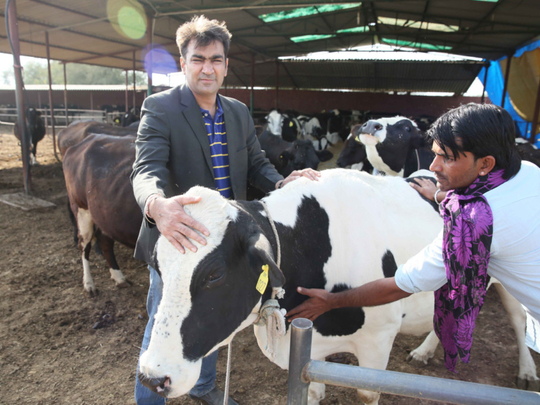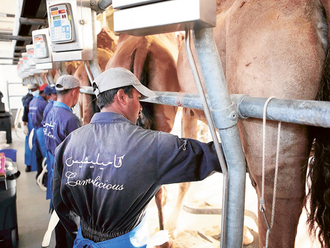
Vigyan Gadodia can talk about benefits of cow milk for hours. And why not. After all, it’s a topic closest to his heart.
“We need to save cows to save the country,” he says at the start of his long conversation on the topic, which is routinely interrupted by servings of butter milk and ice-cream, which are all, as he likes to point out, prepared with cow milk. At lunch, when we are served a preparation of carrot, he doesn’t forget to mention that the vegetable has been grown using “nitrogen-rich water”.
It’s difficult to guess that 40-year-old Gadodia is a biochemical engineer from Indian Institute of Technology (IIT), Delhi. But, while he is multi-tasking — taking calls from his customers in Jaipur and answering queries of new, potential customers on WhatsApp — his training as engineer also comes to the fore. He shows me dried algae in a small vial for which, he says, he has recently tied up with IIT Roorkee. “I have given them a project to see if this can be commercially produced as cattle feed or as bio-fuel mixed with cow dung.”
He adds, in the same vein, that he’s also talking to the Roorkee institute for production of ethanol from weed grasses that have no food application. “World over, people are mixing ethanol with petrol to save depleting oil resources,” he says, adding that he’s working on some more techno-commercial ventures.
It’s clear that although Gadodia has turned a rural entrepreneur to save cows, biotechnology still has a place in his heart.
After he obtained the dual degrees of B Tech and M Tech in biochemical engineering and biotechnology from IIT, Delhi, he completed Masters in Business Administration from Indian Institute of Management (IIM), Kolkata, and then got into banking. In 2006, when he decided to chuck his cushy corporate life, he was head of microfinance vertical at Yes Bank. It was in 2012 that he set up a 1.72 hectare dairy farm in Lisaria village, 70 kilometres north of Rajasthan’s capital of Jaipur, with 16 cows.
Between 2006 and 2012, he tried different things, from vermi-composting to organic farming to running a BPO for a rural NGO. “I wanted to explore opportunities in villages before deciding on what I wanted to do. This could be done only if I stayed in a rural setting. I had lived in metros most of my life and couldn’t shift to a village immediately, so I decided to stay in a rural township, which was close to a city. I decided to spend time in Reengus [on the Jaipur-Bikaner highway],” he says.
Gadodia runs his dairy farm through a company — Sahaj Inclusive Opportunities (India) Private Limited — and is supplying cow milk to 250 customers in Jaipur. Today, he has 150 cows, including calves and heifers, in the herd, and a processing plant that allows him to take cow milk from farmers in his neighbourhood. But more importantly, in 25 villages around Lisaria, almost every farmer is now rearing cows.
There are some, such as the 38-year-old Sitaram Yadav, who now have more cows than buffaloes. “I have been visiting Vigyanji’s farm for three years. I thought if he could quit everything for cows, why couldn’t we rear them? I bought one cow two years ago, then another six months later and in January last year, bought three more. Now, I am producing 50 litres of cow milk and am able to finance the education of my two younger brothers,” says Yadav, who had three buffaloes but has sold two.
Similarly, 55-year-old Ram Kumar of neighbouring Anantpura village had three buffaloes but he sold one and brought three cows in last two years.
Gadodia says he didn’t need to tell farmers about benefits of cow milk. “They know more than me about the animal. I only have to tell them that there’s a market for cow milk, too, and people are even willing to pay a premium if we offer them pure milk,” he says, before explaining that cow milk is lighter on the stomach and digests easily besides being more nutritious than buffalo milk.
“For farmers, what matters,” he adds, “is the price at which they are able to sell their milk. At present, buffalo milk sells at a higher price than cow milk but I have shown them, by example, that there are people who are willing to pay much more for cow milk than for buffalo milk if you give them pure and good quality milk.”
Gadodia says he began with 40 litres of milk, which he brought in public transport before delivering it to his customers’ doorsteps. “You have to make people aware about cows, and as people learn about its benefits, they switch from buffalo milk to cow milk,” he adds.
His farm today produces 500 litres of cow milk with 50 milch cows, but after the processing plant has become active, he has been taking milk from farmers, too. “The farmers will be my satellite farms. They will produce better quality since individual farmers can focus more on their cows. We have promised to pay a premium if they rear indigenous breeds,” he says.
The Sahaj dairy farm will soon start producing a variety of cow milk products such as butter milk, shakes, yogurt drinks and ice-cream. Gadodia’s elder brother, Vidyut, a polymer engineer from IIT Delhi who has been with Reliance Polymers for 20 years, also quit his job in December 2014 to join the farm.
But Gadodia’s aim is not to become a big producer of milk — his goal is making farmers’ lives better. He keeps interacting with scientists at the Rajasthan University of Veterinary and Animal Sciences (RAJUVAS), Bikaner, to learn new things about farming. “I have an MoU with the university for technology extension. We implement new technologies at our farm. Farmers come here, learn about it and take it with themselves,” he says.
Under the MoU, more than 20 farmers received training in hydroponics (a technique where water is used as a cultivation medium) at RAJUVAS for three days recently.
He’s growing Azolla, a fern rich in omega 3, at his farm and feeding it to his cows. Azolla, he tells me, was a chance discovery. He’d gone to Ajmer Krishi Vigyan Kendra (KVK) looking for algae when he chanced upon it. A professor told him about its qualities — that it is rich in omega 3 and its by-product, nitrogen-rich water — and he brought some for his farm.
“Azolla can reduce feed cost. It is far cheaper than the cattle feed and far healthier for the cow and its milk. We can feed up to one kilogram of dried Azolla to a cow,” he says as he shows me around the green carpet of Azolla under a greenhouse.
“My challenge as an engineer is to make technology accessible to farmers. Today they have learnt about Azolla from me but it’s not a knowledge that I discovered. Similarly, there are various other things being worked upon in science laboratories but seldom find their way to farmers,” he says, suddenly slipping back into the shoes of an engineer that he is.
The idea, he explains, is to create micro-entrepreneurs to improve investment appetite in rural India.
He signs off with his latest interest. “I am talking to the scientists at CEERI [Central Electronics Engineering Research Institute] to see how UV technology could be used to arrest growth of bacteria in milk,” he says before rushing off to the milking area to show me how there’s zero human intervention between milking cows and packing it into steel containers.
Rakesh Kumar is a writer based in Jaipur, India.











